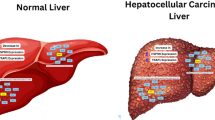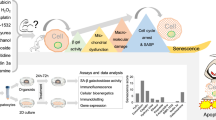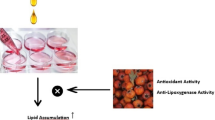Abstract
Matrine is a bioactive component of the traditional Chinese medical herb Sophora flavescens that has been used in China to treat various kinds of diseases including virus hepatitis. However, the molecular mechanisms underlying its hepatoprotective effects remains elusive. In the present study, primary human hepatocytes were employed to elucidate the protective effects and molecular mechanisms of matrine. We observed that low concentrations of matrine had no significant impact on albumin secretion, but high concentrations (>140 mg/L) of matrine decreased the albumin secretion in hepatocytes. Western blot data indicated that matrine at 140 mg/L at 72 h induced protein expression of CYP2A6, CYP2B6 and CYP3A4. Furthermore, high concentrations of matrine reduced LDH and AST levels and were cytotoxic to hepatocytes, leading to a decreased cell viability and total protein amount. Moreover, low concentrations of matrine, enhanced the ECOD activity and decreased the level of NO2 − induced by cytokines in human hepatocytes. Taken together, the present study sheds novel light on the molecular mechanisms of matrine and potential application of matrine in hepatic diseases.




Similar content being viewed by others
Abbreviations
- MA:
-
Matrine
- ALT:
-
Alanine aminotransferase
- AST:
-
Aspartate transaminase
- CYP:
-
Cytochrome P
- ECOD:
-
Ethoxycoumarin-O-deethylation
- EROD:
-
Deethylation of ethoxyresorufin
- GST:
-
Glutathione-S-transferase
- LDH:
-
Lactate dehydrogenase
References
Akuta N, Suzuki F, Kobayashi M, Matsuda M, Sato J, Takagi K, Tsubota A, Suzuki Y, Hosaka T, Someya T, Saitoh S, Arase Y, Ikeda K, Kumada H (2003) Virological and biochemical relapse according to YMDD motif mutant type during long-term lamivudine monotherapy. J Med Virol 71:504–510
Baur H, Kasperek S, Pfaff E (1975) Criteria of viability of isolated liver cells. Hoppe Seylers Z Physiol Chem 356:827–838
Burke MD, Mayer RT (1974) Ethoxyresorufin: direct fluorimetric assay of a microsomal O-dealkylation which is preferentially inducible by 3-methylcholanthrene. Drug Metab Dispos 2:583–588
Burke MD, Orrenius S (1978) The effect of albumin on the metabolism of ethoxyresorufin through O-deethylation and sulphate-conjugation using isolated rat hepatocytes. Biochem Pharmacol 27:1533–1538
Carnovale CE, Scapini C, Alvarez ML, Favre C, Monti J, Carrillo MC (2000) Nitric oxide release and enhancement of lipid peroxidation in regenerating rat liver. J Hepatol 32:798–804
Dorko K, Freeswick PD, Bartoli F, Cicalese L, Bardsley BA, Tzakis A, Nussler AK (1994) A new technique for isolating and culturing human hepatocytes from whole or split livers not used for transplantation. Cell Transplant 3:387–395
Dufour DR, Lott JA, Nolte FS, Gretch DR, Koff RS, Seeff LB (2000) Diagnosis and monitoring of hepatic injury. I. Performance characteristics of laboratory tests. Clin Chem 46:2027–2049
Fontaine H, Pol S (2001) Side effects of interferon-alpha in treating hepatitis C virus infection. Transplant Proc 33:2327–2329
Fry JR, Wiebkin P, Bridges JW (1980) 7-Ethoxycoumarin O-deethylase induction by phenobarbitone and 1,2-benzanthracene in primary maintenance cultures of adult rat hepatocytes. Biochem Pharmacol 29:577–581
Frye RF, Zgheib NK, Matzke GR, Chaves-Gnecco D, Rabinovitz M, Shaikh OS, Branch RA (2006) Liver disease selectively modulates cytochrome P450–mediated metabolism. Clin Pharmacol Ther 80:235–245
Gripon P, Rumin S, Urban S, Le Seyec J, Glaise D, Cannie I, Guyomard C, Lucas J, Trepo C, Guguen-Guillouzo C (2002) Infection of a human hepatoma cell line by hepatitis B virus. Proc Natl Acad Sci USA 99:15655–15660
Hara H, Adachi T (2002) Contribution of hepatocyte nuclear factor-4 to down-regulation of CYP2D6 gene expression by nitric oxide. Mol Pharmacol 61:194–200
Horslen SP, Fox IJ (2004) Hepatocyte transplantation. Transplantation 77:1481–1486
Jover R, Bort R, Gomez-Lechon MJ, Castell JV (2002) Down-regulation of human CYP3A4 by the inflammatory signal interleukin-6: molecular mechanism and transcription factors involved. FASEB J 16:1799–1801
Katenz E, Vondran FW, Schwartlander R, Pless G, Gong X, Cheng X, Neuhaus P, Sauer IM (2007) Cryopreservation of primary human hepatocytes: the benefit of trehalose as an additional cryoprotective agent. Liver Transpl 13:38–45
Lau DT, Khokhar MF, Doo E, Ghany MG, Herion D, Park Y, Kleiner DE, Schmid P, Condreay LD, Gauthier J, Kuhns MC, Liang TJ, Hoofnagle JH (2000) Long-term therapy of chronic hepatitis B with lamivudine. Hepatology 32:828–834
Li CQ, Zhu YT, Zhang FX, Fu LC, Li XH, Cheng Y, Li XY (2005) Anti-HBV effect of liposome-encapsulated matrine in vitro and in vivo. World J Gastroenterol 11:426–428
Liu J, Zhu M, Shi R, Yang M (2003) Radix Sophorae flavescentis for chronic hepatitis B: a systematic review of randomized trials. Am J Chin Med 31:337–354
Lloyd TD, Orr S, Patel R, Crees G, Chavda S, Vadyar H, Berry DP, Sherlock D, Dennison AR (2004) Effect of patient, operative and isolation factors on subsequent yield and viability of human hepatocytes for research use. Cell Tissue Bank 5:81–87
Lok AS, McMahon BJ (2001) Chronic hepatitis B. Hepatology 34:1225–1241
Manns MP (2002) Current state of interferon therapy in the treatment of chronic hepatitis B. Semin Liver Dis 22(Suppl 1):7–13
Marzinzig M, Nussler AK, Stadler J, Marzinzig E, Barthlen W, Nussler NC, Beger HG, Morris SM Jr, Bruckner UB (1997) Improved methods to measure end products of nitric oxide in biological fluids: nitrite, nitrate, and S-nitrosothiols. Nitric Oxide 1:177–189
Miranda JP, Leite SB, Muller-Vieira U, Rodrigues A, Carrondo MJ, Alves PM (2009) Towards an extended functional hepatocyte in vitro culture. Tissue Eng Part C Methods 15:157–167
Morsiani E, Brogli M, Galavotti D, Pazzi P, Puviani AC, Azzena GF (2002) Biologic liver support: optimal cell source and mass. Int J Artif Organs 25:985–993
Nebert DW, Russell DW (2002) Clinical importance of the cytochromes P450. Lancet 360:1155–1162
Nussler AK, Liu ZZ, Di Silvio M, Sweetland MA, Geller DA, Lancaster JR Jr, Billiar TR, Freeswick PD, Lowenstein CL, Simmons RL (1994) Hepatocyte inducible nitric oxide synthesis is influenced in vitro by cell density. Am J Physiol 267:C394–C401
Sen S, Williams R, Jalan R (2002) The pathophysiological basis of acute-on-chronic liver failure. Liver 22(Suppl 2):5–13
Si W-K, Pan J, Lu H, Li Z-Q (2001) Study on matrine inhibiting proliferation of HepG2 cell and the relation between its dosage and inhibiting style. World J Gastroenterol 9:5
Skibba JL, Gwartney EA (1997) Liver hyperthermia and oxidative stress: role of iron and aldehyde production. Int J Hyperthermia 13:215–226
Takahashi S, Yamazoe H, Sassa F, Suzuki H, Fukuda J (2009) Preparation of coculture system with three extracellular matrices using capillary force lithography and layer-by-layer deposition. J Biosci Bioeng 108:544–550
Tang W, Stearns RA (2001) Heterotropic cooperativity of cytochrome P450 3A4 and potential drug-drug interactions. Curr Drug Metab 2:185–198
Taylor BS, Alarcon LH, Billiar TR (1998) Inducible nitric oxide synthase in the liver: regulation and function. Biochemistry (Mosc) 63:766–781
Torre D, Pugliese A, Speranza F (2002) Role of nitric oxide in HIV-1 infection: friend or foe? Lancet Infect Dis 2:273–280
Wan XY, Luo M, Li XD, He P (2009) Hepatoprotective and anti-hepatocarcinogenic effects of glycyrrhizin and matrine. Chem Biol Interact 181:15–19
Wang L, You Y, Wang S, Liu X, Liu B, Wang J, Lin X, Chen M, Liang G, Yang H (2012) Synthesis, characterization and in vitro anti-tumor activities of matrine derivatives. Bioorg Med Chem Lett 22:4100–4102
Watts P, Smith MD, Edwards I, Zammit V, Brown V, Grant H (1995) The influence of medium composition on the maintenance of cytochrome P-450, glutathione content and urea synthesis: a comparison of rat and sheep primary hepatocyte cultures. J Hepatol 23:605–612
Weigand K, Otto I (1974) Secretion of serum albumin by enzymatically isolated rat liver cells. FEBS Lett 46:127–129
Wright TL (2006) Introduction to chronic hepatitis B infection. Am J Gastroenterol 101(Suppl 1):S1–S6
Zamora R, Vodovotz Y, Billiar TR (2000) Inducible nitric oxide synthase and inflammatory diseases. Mol Med 6:347–373
Zhang B, Liu ZY, Li YY, Luo Y, Liu ML, Dong HY, Wang YX, Liu Y, Zhao PT, Jin FG, Li ZC (2011) Antiinflammatory effects of matrine in LPS-induced acute lung injury in mice. Eur J Pharm Sci 44:573–579
Zhao X, Kan Q, Zhu L, Zhang GX (2011) Matrine suppresses production of IL-23/IL-17 and ameliorates experimental autoimmune encephalomyelitis. Am J Chin Med 39:933–941
Zimmerman HJ, Kodera Y, West M (1965) Rate of increase in plasma levels of cytoplasmic and mitochondrial enzymes in experimental carbon tetrachloride hepatotoxicity. J Lab Clin Med 66:315–323
Acknowledgments
The authors declare no conflict of interest. This work was supported by the Scientific Research Foundation for the Returned Overseas Chinese Scholars, State Ministry of Education (Grant No. 890[2008]) and the Medical Scientific Research Foundation of Guangdong Province (Grant No. A2009357).
Author information
Authors and Affiliations
Corresponding author
Additional information
Xiaobing Gong and Yuan Gao have contributed equally to this work.
Electronic supplementary material
Below is the link to the electronic supplementary material.
Rights and permissions
About this article
Cite this article
Gong, X., Gao, Y., Guo, G. et al. Effect of matrine on primary human hepatocytes in vitro. Cytotechnology 67, 255–265 (2015). https://doi.org/10.1007/s10616-013-9680-1
Received:
Accepted:
Published:
Issue Date:
DOI: https://doi.org/10.1007/s10616-013-9680-1




